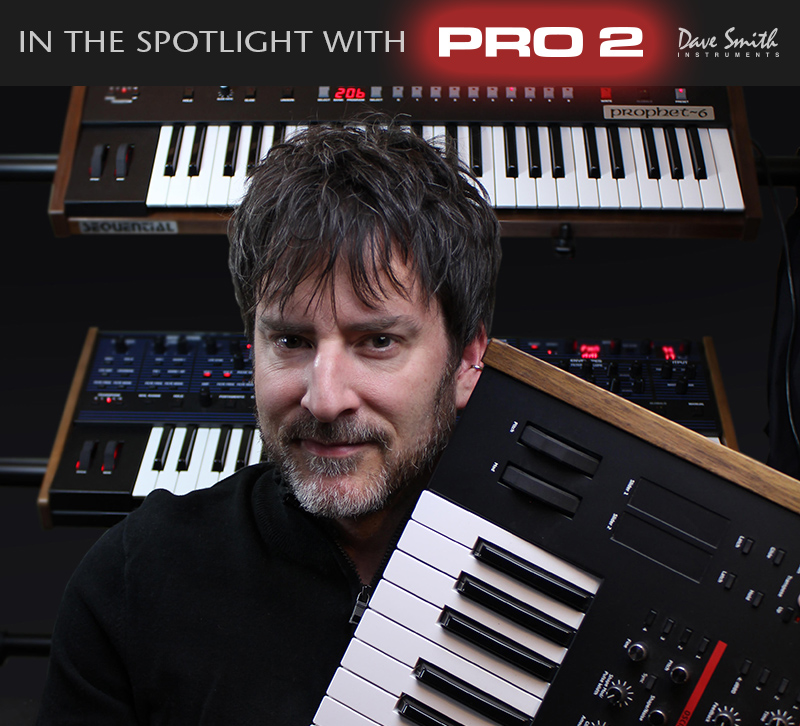
Marc Doty is the composer, synthesist, and educator responsible for the popular analog synth demonstration YouTube channel, Automatic Gainsay.
We chatted with Marc about how he’s using the Pro 2.
Marc, what made you choose the Pro 2?
“When the Pro 2 was first announced, I was completely fascinated by the concept of being able to voltage control modulation of filter type. In my exploration of vintage analog synths, I had never experienced that, and I wanted to. On top of that, being able to voltage control the relationship between two filters of differing types… well, I saw a lot of unique potential in that. That’s why I contacted DSI for the first time in regard to demonstrating it.”
How are you using it?
“Once I got hold of one, I was not prepared for how truly complex it is. I thought it was a full-functioned, four-oscillator monosynth. But it’s really a gigantic modular smashed down into a keyboard shape. Because of that, I am able to use it for literally any application I can think of. I compose music in a wide variety of styles using a wide variety of instruments, and I have always wanted a synthesizer that wasn’t adept just at making “synthesizer sounds,” but adept at actually authoring sound in general. It became apparent to me very quickly that the Pro 2 was that synth for me.“
“I have a variety of iconic vintage synths like the Minimoog and the ARP 2600, but the Pro 2 is my go-to synth for any practical purpose. I have yet to have needed a sound that I couldn’t make with the Pro 2. So, to answer your question… it is the center of my studio.”
What’s one of your favorite things about it?
“I am an analog synthesizer aficionado. I love the idea of electricity coursing through wires and vintage architecture as a tool to create sound. But as has been pointed out to me so many times, “Marc, you’re an analog nut… how do you stand the fact that it has digital oscillators?”
“The fact is, DSI has given me all of the tools I need to author “analog” tone. Yep, I said it. It’s true. Because I have the ability to introduce variability and/or instability in waveshape, tuning, and amplitude… because I have the ability to introduce low-level analog distortion… because I have multiple modulation sources to control these factors… I can make the Pro 2 sound as analog as I would ever want.”
“It is for that reason that the Pro 2 has ruined my analog-only attitude. It has given me the tools to create the sounds I want, and a hands-on and aesthetically pleasing interface in order to use them.”
What does it give you that other synths might not?
“As an analog guy, I’m used to a couple of oscillators, a filter, an LFO, a couple of envelopes, and an amp. The Pro 2 gives me four oscillators with many waveforms, four LFOs for complex modulation, two different filters, and five envelopes… as well as other functions. On top of that, it allows me to connect any of them with simplicity and immediacy. Like I said earlier… giant modular.”
“I’m not sure how DSI got away with giving so much… and then making so much of it analog on top of that.”
Any interesting Pro 2 tricks or techniques you’d like to share?
“Well, one of my big interests is what I call “articulated polyphony.” Polyphonic synths tend to force you to use a single waveform per set of voices… if you have a single-osc 6-voice polyphonic, you can’t choose different waveforms or frequencies for those six iterations of the oscillator. With the Pro 2, I can shift into what they call “paraphonic” mode, and the individual oscillators that make up the 4-voice polyphony can be set individually to anything… any frequency, waveshape, and so on. It allows for really colorful and interesting polyphonic outcomes.”
“Something people don’t seem to realize is that the Pro 2 is set up so that you can apply envelopes to oscillator amplitudes. It’s basically a digital trick that allows you to articulate your oscillators amplitude-wise! The currently-held definition of “paraphonic” describes a situation where a single envelope and amp controls the amplitude of multiple oscillators. Because you can digitally apply four of the envelopes to four of the oscillators, the “paraphonic” label isn’t entirely true! On top of that, because you can direct two oscillators to one filter and two oscillators to another filter, the “single filter/single filter envelope” aspect of the term “paraphonic” isn’t entirely true in regard to the Pro 2, either. You can create a lot more interesting polyphony with the Pro 2 than you can with a synth that has the limitations of paraphony.”
“I could probably go on for hours listing off unique applications of the complex Pro 2 functionality. It is just so seemingly unlimited.”
Check out Marc Doty’s website here.
Check out some of Marc Doty’s music here.
MORE ABOUT THE PRO 2
For more information, check out the Pro 2 product page here.
Find your local dealer for Pro 2 pricing here.
If you’re using the Pro 2 in interesting ways, tell us about it. Contact us at .
